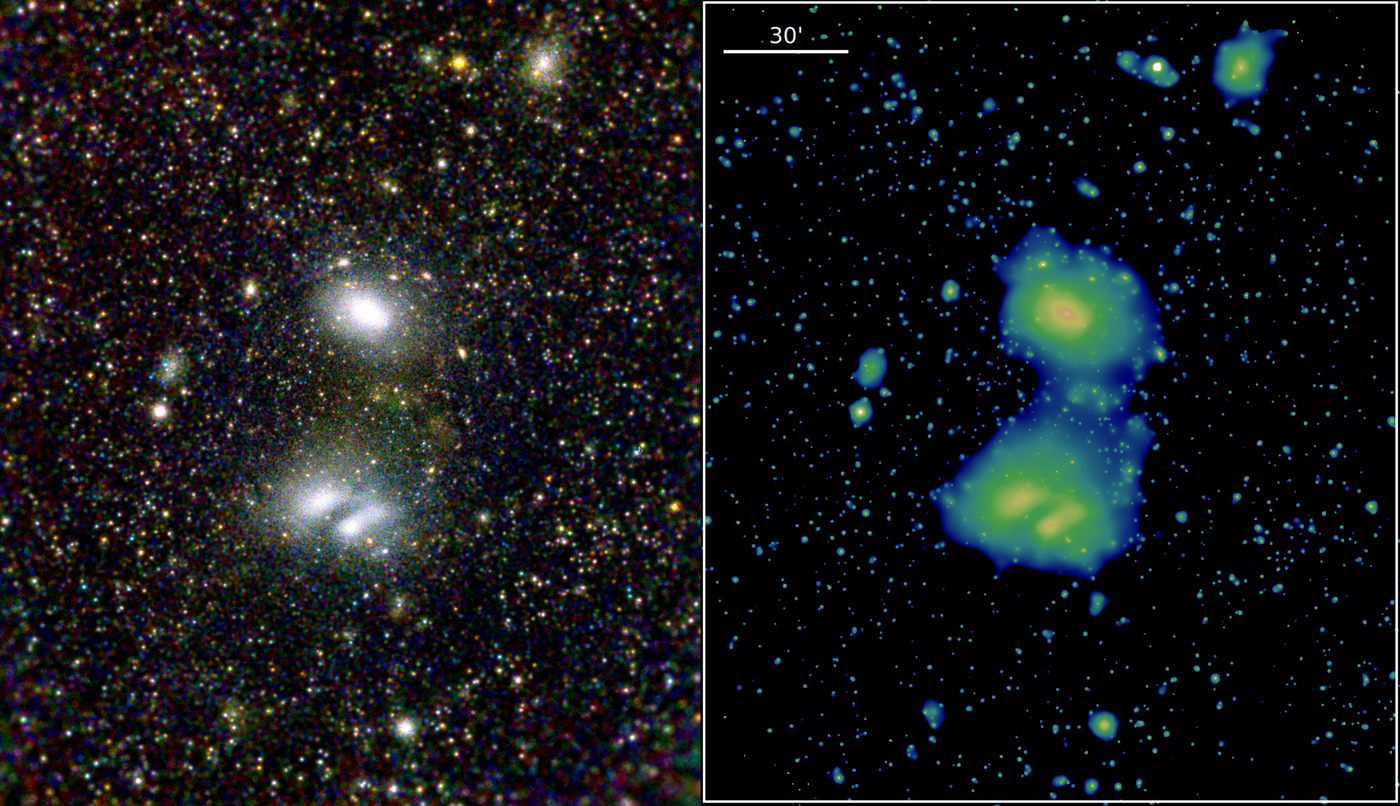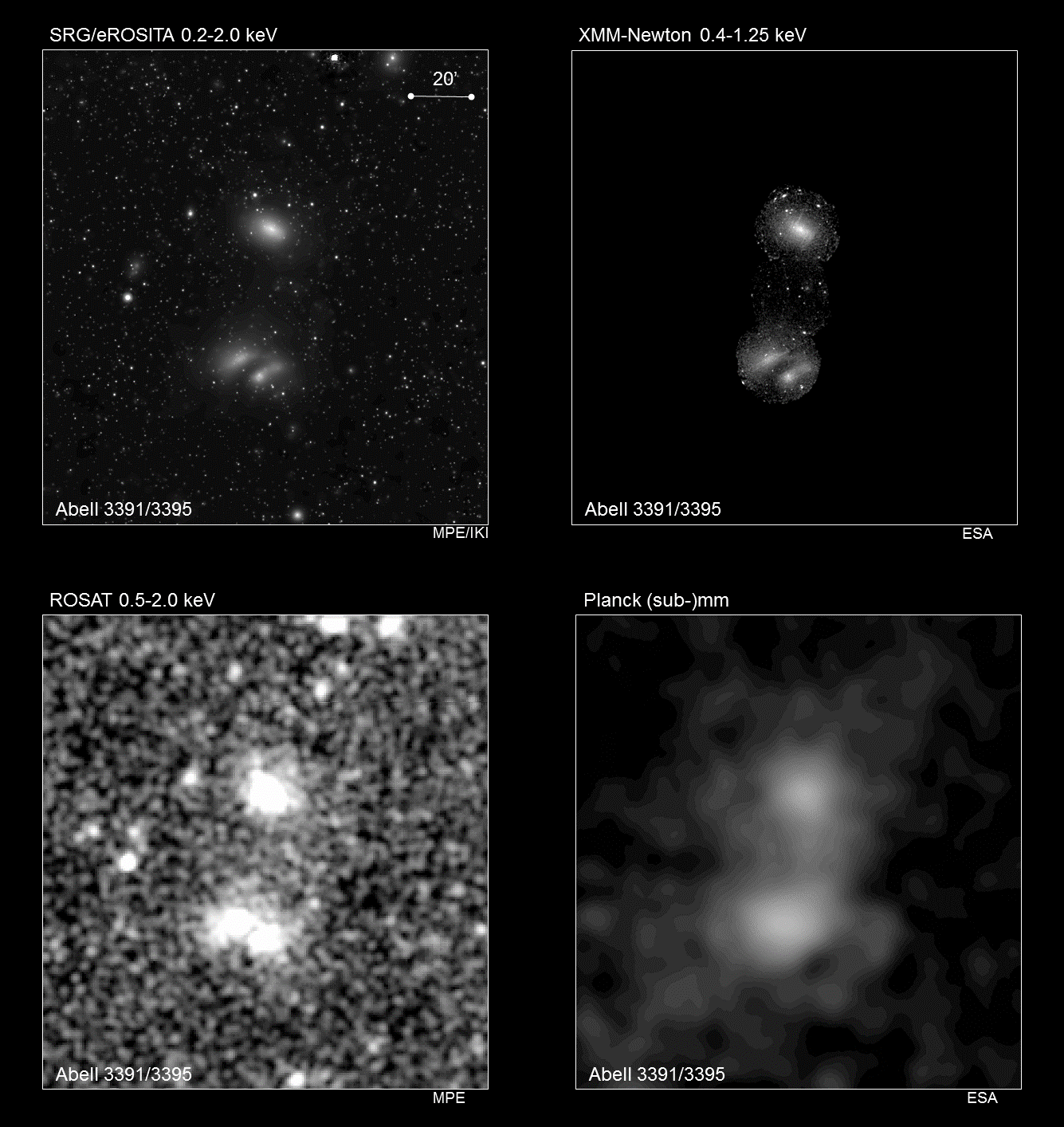Revealing the Beauty of the Hidden Universe: eROSITA sees first light
The scientific performance demonstrated in the first weeks of operations of the eROSITA X-ray telescope promises a breakthrough in our understanding of the energetic Universe.
On 22 October 2019, the beautiful first X-ray images of the eROSITA telescope were presented to the public at the Max Planck Institute for Extraterrestrial Physics (MPE) in Garching. After an extended commissioning phase, since October 13 all seven X-ray telescope modules with their custom-designed CCD cameras have been observing the sky simultaneously. The first combined X-ray images of our neighbouring galaxy, the Large Magellanic Cloud, and a pair of interacting clusters of galaxies at a distance of about 800 Million lightyears, show remarkable details and demonstrate the promise of the ambitious science programme planned with the space-borne telescope.
“These first images from our telescope show the true beauty of the hidden Universe,” enthuses Peter Predehl, Principal Investigator of eROSITA. “To meet our science goals we needed enough sensitivity to detect the most distant clusters of galaxies in the Universe over the whole sky, and resolve them spatially. These First Light images show that we can do exactly that, but we can go a lot further.” In addition to the sharp X-ray vision provided by each of eROSITA’s seven mirrors, each telescope is equipped with state-of-the-art CCD cameras with superb spectral and timing resolution. “The potential for new discoveries is immense. Now we can start reaping the fruits of more than ten years of work,” adds Predehl.
The eROSITA ‘First Light’ images were obtained in a series of exposures of all seven telescope modules with a combined integration time of about one day for both the Large Magellanic Cloud (LMC), our neighbouring galaxy, and the A3391/3395 system of interacting clusters of galaxies at a distance of about 800 Million lightyears.

This image shows our neighbouring galaxy, the Large Magellanic Cloud, observed in series of exposures with all seven eROSITA telescope modules taken from 18 to 19 October 2019. The diffuse emission originates from the hot gas between the stars. The nebulous structures in the image are mainly supernova remnants, i.e. stellar atmospheres expelled in huge explosions at the end of a massive stars’ lifetime. The most prominent one, SN1987A, is seen close to the centre as an almost circular, bluish cloud. A host of other sources in the LMC itself include accreting binary stars or stellar clusters with very massive young stars (up to 100 solar masses and more). There are also a number of point sources, either foreground stars from our home galaxy or distant Active Galactic Nuclei. Image: © F.Haberl, M.Freyberg, C.Maitra, MPE/IKI
In our neighbouring galaxy, the LMC, eROSITA not only shows the distribution of the diffuse hot gas, but also some remarkable details, such as supernova remnants like SN1987A. The eROSITA image now confirms that this source is becoming fainter, as the shock wave produced by the stellar explosion in 1987 propagates through the interstellar medium. In addition to a host of other hot objects in the LMC itself, eROSITA also reveals a number of foreground stars from our own Milky Way galaxy as well as distant Active Galactic Nuclei, whose radiation pierces the diffuse emission of the hot gas in the LMC.
“X-rays give us a unique view of the Universe, hidden in visible light”, explains Kirpal Nandra, director of High Energy astrophysics at MPE. “Looking at an apparently normal star, in X-rays we might see an orbiting white dwarf or neutron star in the process of devouring its companion. Visible light shows the structure of a galaxy traced by its stars, but the X-rays are dominated by supermassive black holes growing at their centres. And where we see clusters of galaxies with optical telescopes, X-rays reveal the huge reservoirs of gas filling the space between them and tracing out the dark matter structure of the Universe. With its performance demonstrated, we now know that eROSITA will lead to a breakthrough in our understanding of the evolution of the energetic Universe.”
Reaching further out into the Universe, the eROSITA image of the A3391/3395 system of interacting clusters of galaxies highlights the dynamical processes which lead to the formation of gigantic structures in the Universe. The clusters, appearing as large, elliptical nebulae in the eROSITA images, span tens of millions of lightyears across, and contain thousands of galaxies each. Clusters are one of the main science targets for eROSITA; astronomers expect to find some 100,000 X-ray emitting galaxy clusters as well as several million active black holes in the centres of galaxies during its 4-year all-sky survey in the soft and hard X-ray bands. “By measuring the evolution of these clusters over cosmic time, we can make precision measurements of the cosmological parameters to better understand the dark matter and dark energy that dominate the Universe” says astrophysicist Esra Bulbul, who leads the work on clusters and cosmology at MPE.

These two eROSITA images show the two interacting galaxy clusters A3391, to the top of the image, and the double-peaked cluster A3395, to the bottom, highlighting eROSITAs superb view of the distant Universe. They were observed in series of exposures with all seven eROSITA telescope modules taken from 17 to 18 October 2019. The individual images were subjected to different analysis techniques, and then coloured in different schemes to highlight the different structures. In the left-hand image, the red, green and blue colours refer to the three different energy bands of eROSITA. One clearly sees the two clusters as nebulous structures, which shine brightly in X-rays due to the presence of extremely hot gas (tens of millions of degrees) in the space between galaxies. The image on the right highlights the “bridge” or “filament” between the two clusters, confirming the suspicion that these two huge structures actually interact dynamically. The eROSITA observations also show hundreds of point-like sources, signposting either distant supermassive black holes or hot stars in the Milky Way. Image: © T. Reiprich (Univ. Bonn), M. Ramos-Ceja (MPE), F. Pacaud (Univ. Bonn), D. Eckert (Univ. Geneva), J. Sanders (MPE), N. Ota (Univ. Bonn), E. Bulbul (MPE), V. Ghirardini (MPE), MPE/IKI
“This is a dream come true. We now know that eROSITA can deliver on its promise and create a map of the whole X-ray sky with unprecedented depth and detail,” confirms Andrea Merloni, eROSITA Project Scientist. “The legacy value will be enormous. Beside the beautiful images like the ones we’re showing today, catalogues of millions of exotic celestial objects such as black holes, galaxy clusters, neutron stars, supernovae and active stars will be used by astronomers for years to come.”
Launched on 13 July 2019 as part of the Russian-German Spektrum-Roentgen-Gamma (SRG) space mission, which also includes the Russian ART-XC telescope, eROSITA completed its 1.5 million kilometre journey to the second Lagrange point (L2) of the Earth-Sun-system on October 21, and has now – 100 days after launch – entered its target orbit around L2. The commissioning phase of the telescope was officially completed on October 13. While the scientific performance of the system is outstanding, this first phase was not problem-free.
“The commissioning phase lasted longer than expected, after we found some anomalies in the electronic controls of the cameras,” explains Peter Predehl. “But teasing out these problems is exactly why we have such a phase. After a careful analysis we determined that the issues are not critical. We’re still working on them, but in the meantime the programme can go forward normally.” The telescope has now entered the so-called calibration and performance verification (CalPV) phase, during which astronomical observations are carried out to better understand the instrument and verify its full potential to meet the scientific requirements. At the end of the CalPV phase, after a final review by the operations team, SRG and eROSITA will enter into its prime phase, the four year all-sky X-ray survey.

Comparison of the eROSITA First Light image (top left) of the two interacting galaxy clusters A3391 and A3395 with other images of the same system: by the ESA X-ray telescope XMM-Newton (top right), the ROSAT X-ray camera (bottom left), and by the Planck satellite (bottom right), which was observing at much lower energy (sub-millimetre wavelengths). Image: © T. Reiprich (Univ. Bonn), M. Ramos-Ceja (MPE), F. Pacaud (Univ. Bonn), D. Eckert (Univ. Geneva), J. Sanders (MPE), N. Ota (Univ. Bonn), E. Bulbul (MPE), V. Ghirardini (MPE), J. Erler (Univ. Bonn), A. Veronica (Univ. Bonn)
The development and construction of the eROSITA X-ray telescope was led by the Max Planck Institute for Extraterrestrial Physics with contributions from the Institute for Astronomy and Astrophysics of the University Tübingen, the Leibniz Institute for Astrophysics Potsdam (AIP), University Observatory Hamburg, and Dr. Karl Remeis Observatory Bamberg, with the support of the German space agency DLR. The Ludwig-Maximilians-Universität Munich and the Argelander Institute for Astronomy of the University Bonn also participated in the science preparation for eROSITA. The Russian partner Institute is the Space Research Institute IKI in Moskow; NPOL, Lavochkin Association, in Khimky, near Moskow, is responsible for the technical implementation of the whole SRG mission, which is a joint project of the Russian and German space agencies, Roscosmos and DLR.
The Argelander Institute for Astronomy (AIfA) of the University Bonn coordinates the eROSITA observing program targeting the interacting galaxy cluster system shown in the images. “The quality of the eROSITA observations has exceeded our expectations and we are all excited to continue spending the coming days and nights analyzing these spectacular data” says Thomas Reiprich, head of AIfA’s dark energy research group.
Further information:
More “First Light“ images:
http://www.mpe.mpg.de/7362694/presskit-erosita-firstlight
eROSITA webpages at MPE:
http://www.mpe.mpg.de/eROSITA
Video with Prof. Dr. Thomas Reiprich:
(Video was filmed and produced by the Astronomy on Tap Bonn team and Laila Linke, MSc at AIfA.)
http://www.youtube.com/watch?v=-Z1HaMNDlgk
Contacts for the media:
Prof. Dr. Thomas Reiprich
Argelander Institute for Astronomie (AIfA)
University of Bonn
Tel. +49 228 73 3642
E-Mail: reiprich@astro.uni-bonn.de
Dr. Peter Predehl
Project Manager eROSITA
Max Planck Institute for Extraterrestrial Physics (MPE)
Tel: +49 89 30000-3505
Mobile: +49 151 12113639
Email: prp@mpe.mpg.de
Dr. Andrea Merloni
Project Scientist eROSITA
Max Planck Institute for Extraterrestrial Physics
Tel: +49 89 30000 3893
Email: am@mpe.mpg.de
Prof. Dr. Kirpal Nandra
Director and Head of the High-Energy Astrophysics Group
Max Planck Institute for Extraterrestrial Physics
Tel: +49 89 30000 3401
Email: knandra@mpe.mpg.de
- 22.10.2019